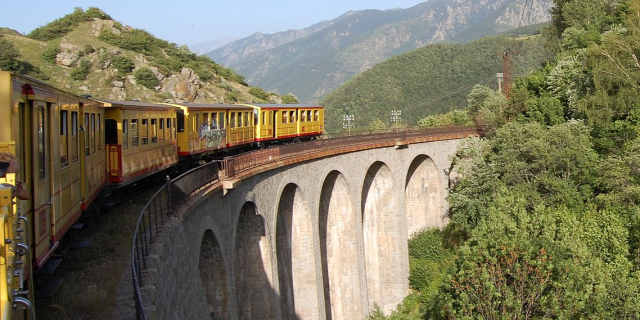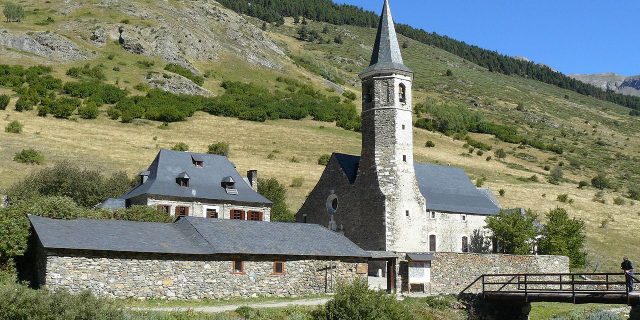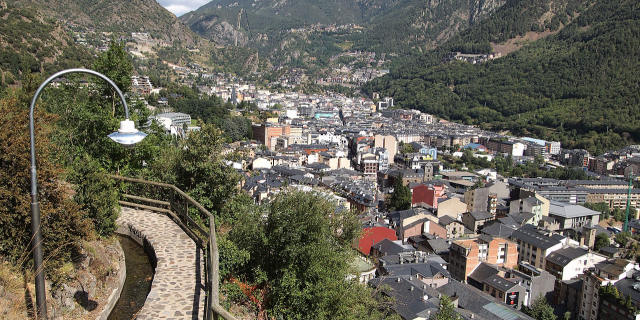France
បារាំងContext of បារាំង
ប្រទេសបារាំង (បារាំង: France ហ្វ្រង្សិ៍) ដោយមានឈ្មោះផ្លូវការថា សាធារណរដ្ឋបារាំង គឺជាប្រទេសឆ្លងទ្វីបមួយដែលមានទឹកដីចម្បងស្ថិតនៅតំបន់អឺរ៉ុបខាងលិចនិងមានទឹកដីក្រៅស្រុកមួយចំនួនស្ថិតនៅតាមទ្វីបអាមេរិកខាងត្បូង និងរួមទាំងមហាសមុទ្រអាត្លង់ទិក មហាសមុទ្រប៉ាស៊ីហ្វិក និងមហាសមុទ្រឥណ្ឌា។ តំបន់មាតុបុរៈរបស់ប្រទេសនេះលាតសន្ធឹងពីតំបន់រ៉ាំងនៅភាគខាងកើតទៅដល់មហាសមុទ្រអាត្លង់ទិកនៅភាគខាងលិច និងពីសមុទ្រមេឌីទែរ៉ានេនៅភាគខាងត្បូងដល់ផ្លូវទឹកអង់គ្លេស និងសមុទ្រខាងជើង។ ទឹកដីក្រៅប្រទេសរួមមាន៖ គុយយ៉ានបារាំងនៅអាមេរិកខាងត្បូង សង់ព្យែរនិងមីកូឡុងនៅសមុទ្រអាត្លង់ទិកខាងជើង ឥណ្ឌីបារាំងខាងលិច និងបណ្តុំកោះជាច្រើនទៀតនៅទ្វីបអូសេអានី និងមហាសមុទ្រឥណ្ឌា។ ដោយសារតែមានទឹកដីជាប់មាត់សមុទ្រច្រើន ប្រទេសបារាំងមានតំបន់សេដ្ឋកិច្ចផ្តាច់មុខដ៏ធំបំផុតលើពិភពលោក។ នៅប៉ែកអឺរ៉ុប បារាំងមានព្រំប្រទល់ជាប់នឹងប្រទេសបែលហ្សិក លុចសំបួ អាល្លឺម៉ង់ ស្វីស ម៉ូណាកូ អ៊ីតាលី អង់ដូរ៉ា និងប្រទេសអេស្ប៉ាញ រីឯនៅទ្វីបអាមេរិកវិញ វាមានព្រំប្រទល់ជាប់ប្រទេសហុល្លង់ ស៊ូរីណាម និងប្រទេសប្រេស៊ីល។ បារាំងមានតំបន់អាំងតេក្រាលចំនួនដប់ប្រាំបី (ប្...អានបន្ថែម
ប្រទេសបារាំង (បារាំង: France ហ្វ្រង្សិ៍) ដោយមានឈ្មោះផ្លូវការថា សាធារណរដ្ឋបារាំង គឺជាប្រទេសឆ្លងទ្វីបមួយដែលមានទឹកដីចម្បងស្ថិតនៅតំបន់អឺរ៉ុបខាងលិចនិងមានទឹកដីក្រៅស្រុកមួយចំនួនស្ថិតនៅតាមទ្វីបអាមេរិកខាងត្បូង និងរួមទាំងមហាសមុទ្រអាត្លង់ទិក មហាសមុទ្រប៉ាស៊ីហ្វិក និងមហាសមុទ្រឥណ្ឌា។ តំបន់មាតុបុរៈរបស់ប្រទេសនេះលាតសន្ធឹងពីតំបន់រ៉ាំងនៅភាគខាងកើតទៅដល់មហាសមុទ្រអាត្លង់ទិកនៅភាគខាងលិច និងពីសមុទ្រមេឌីទែរ៉ានេនៅភាគខាងត្បូងដល់ផ្លូវទឹកអង់គ្លេស និងសមុទ្រខាងជើង។ ទឹកដីក្រៅប្រទេសរួមមាន៖ គុយយ៉ានបារាំងនៅអាមេរិកខាងត្បូង សង់ព្យែរនិងមីកូឡុងនៅសមុទ្រអាត្លង់ទិកខាងជើង ឥណ្ឌីបារាំងខាងលិច និងបណ្តុំកោះជាច្រើនទៀតនៅទ្វីបអូសេអានី និងមហាសមុទ្រឥណ្ឌា។ ដោយសារតែមានទឹកដីជាប់មាត់សមុទ្រច្រើន ប្រទេសបារាំងមានតំបន់សេដ្ឋកិច្ចផ្តាច់មុខដ៏ធំបំផុតលើពិភពលោក។ នៅប៉ែកអឺរ៉ុប បារាំងមានព្រំប្រទល់ជាប់នឹងប្រទេសបែលហ្សិក លុចសំបួ អាល្លឺម៉ង់ ស្វីស ម៉ូណាកូ អ៊ីតាលី អង់ដូរ៉ា និងប្រទេសអេស្ប៉ាញ រីឯនៅទ្វីបអាមេរិកវិញ វាមានព្រំប្រទល់ជាប់ប្រទេសហុល្លង់ ស៊ូរីណាម និងប្រទេសប្រេស៊ីល។ បារាំងមានតំបន់អាំងតេក្រាលចំនួនដប់ប្រាំបី (ប្រាំនៅក្រៅប្រទេស) ដែលលាតសន្ធឹងលើផ្ទៃដីសរុប ៦៤៣,៨០១ គីឡូម៉ែត្រក្ររ៉េ និងមានប្រជាជនជាង ៦៧ លាននាក់ (គិតត្រឹមខែឧសភា ឆ្នាំ២០២១)។ ប្រទេសបារាំងគឺជាសាធារណរដ្ឋឯកភូតប្រកាន់ប្រព័ន្ធពាក់កណ្តាលប្រធានាធិបតីនិយម ដែលមានរដ្ឋធានីឈ្មោះថាប៉ារីសដោយវាត្រូវជាទីក្រុងធំបំផុតក្នុងប្រទេស និងជាមជ្ឈមណ្ឌលវប្បធម៌ និងពាណិជ្ជកម្មដ៏សំខាន់។ តំបន់ទីក្រុងសំខាន់ៗផ្សេងទៀតរួមមាន៖ លីយ៉ុង ម៉ាសែល ធូលូស ប័រដូ លីល និងនីស។
ទឹកដីបារាំងសព្វថ្ងៃបានទទួលវត្តមានមនុស្សដំបូងៗតាំងពីស័កប៉ាលេអូលីទិកមកម្លេះ ហើយទឹកដីមាតុបុរៈបារាំងត្រូវកុលសម្ព័ន្ធសែលតិកមួយក្រុមដែលគេស្គាល់ថា"ហ្គោល"ចូលមកតាំងទីលំនៅក្នុងអំឡុងយុគដែក។ ពួករ៉ូមបានកាត់តំបន់នេះបញ្ចូលជាផ្នែកមួយនៃទឹកដីខ្លួននៅក្នុងឆ្នាំ ៥១ មុន គ.ស ដែលជាហេតុនាំឱ្យវប្បធម៌ហ្កាល់ឡូ-រ៉ូម៉ាំងលេចឡើង និងត្រូវជាមូលដ្ឋានគ្រឹះនៃភាសាបារាំង។ ពួកហ្វ្រង់ដែលជាក្រុនជនជាតិជឺម៉ាំងមួយបានបង្កើតព្រះរាជាណាចក្រហ្វ្រង់ស៊ា ហើយបានក្លាយជាមាតុបេះដូងនៃចក្រភពការអូលីនជាន។ សន្ធិសញ្ញាវ៉ែដុងនៃឆ្នាំ ៨៤៣ បានបែងចែកចក្រភពនោះដោយមានរដ្ឋហ្វ្រង់ស៊ាខាងលិចក្លាយទៅជាព្រះរាជាណាចក្របារាំងនៅក្នុងឆ្នាំ៩៨៧។ នៅយុគសម័យកណ្តាល បារាំងបានក្លាយជាអាណាចក្រសក្តិភូមិដ៏មានឥទ្ធិពលមួយ ហើយមានវិមជ្ឈការខ្ពស់។ ស្តេចហ្វីលីពទី២ បានពង្រឹងអំណាចរាជវង្សប្រកបដោយជោគជ័យ ហើយបានកម្ចាត់ចោលនូវគូប្រជែងរបស់ទ្រង់ដើម្បីបង្កើនវិសាលភាពរាជ្យទឹកដីបារាំង។ នៅចុងរជ្ជកាលរបស់ព្រះអង្គ ប្រទេសបារាំងបានក្លាយទៅជារដ្ឋដ៏មានឥទ្ធិពលបំផុតនៅទ្វីបអឺរ៉ុប។ ចាប់ពីពាក់កណ្តាលសតវត្សទី១៤ ដល់ពាក់កណ្តាលសតវត្សទី១៥ ប្រទេសបារាំងបានធ្លាក់ចូលទៅក្នុងជម្លោះរាជវង្សជាបន្តបន្ទាប់ដែលមានប្រទេសអង់គ្លេសជាប់ពាក់ព័ន្ធ គេតែងសម្តៅលើជម្លោះនេះថាសង្រ្គាមមួយរយឆ្នាំ ហើយអត្តសញ្ញាណរបស់បារាំងថ្មីបានលេចឡើងជាលទ្ធផល។ នៅក្នុងសម័យបុនវុឌ្ឍិសិល្បៈ (Renaissance) ប្រទេសបារាំងបានឆ្លងកាត់វឌ្ឍនភាពសិល្បៈនិងវប្បធម៌ ជម្លោះជាមួយរាជត្រកូលហាបស្បួក និងនិម្មិតកម្មនៃចក្រភពអាណានិគមលំដាប់ពិភពលោកដែលដល់សតវត្សទី២០ វាក៏ក្លាយជាចក្រភពមហាអំណាចធំទីពីរនៅលើភពផែនដី។ នៅពាក់កណ្តាលទីពីរនៃសតវត្សទី១៦ បារាំងត្រូវប្រឈមនឹងសង្រ្គាមស៊ីវិលសាសនារវាងអ្នកកាន់និកាយកាតូលិកនិងពួកហ៊ូហ្គូណូដែលជាហេតុនាំឱ្យប្រទេសចុះទន់ខ្សោយយ៉ាងខ្លាំង។ ប្រទេសបារាំងបានលេចចេញជាមហាអំណាចសារជាថ្មីនៅអឺរ៉ុបក្នុងសតវត្សទី១៧ ក្រោមការដឹកនាំរបស់ស្តេចនាមល្វីទី១៤ បន្ទាប់ពីទ្រង់បានបិទបញ្ចប់ឆាកសង្រ្គាមសាមសិបឆ្នាំ។ កង្វះគោលនយោបាយសេដ្ឋកិច្ច ពន្ធវិសមភាព និងសង្រ្គាមជាញឹកញាប់ (ជាពិសេសការបរាជ័យនៅក្នុងសង្គ្រាមប្រាំពីរឆ្នាំ និងការចូលធ្វើអន្តរាគមន៍នៅក្នុងសង្គ្រាមឯករាជ្យអាមេរិក) បាននាំឱ្យព្រះរាជាណាចក្រធ្លាក់ក្នុងស្ថានភាពសេដ្ឋកិច្ចមិនជាក់លាក់នៅចុងសតវត្សទី១៨។ បញ្ហាទាំងនេះបានធ្វើឱ្យបដិវត្តន៍បារាំងផ្ទុះឡើងនៅក្នុងឆ្នាំ១៧៨៩ ដែលជាលទ្ធផល របបចាស់ (Ancien Régime) ត្រូវបានគេផ្តួលរំលំ និងការបង្កើតនូវសេចក្តីប្រកាសសិទ្ធិមនុស្ស ដែលបង្ហាញពីឧត្តមគតិរបស់ប្រទេសនេះរហូតមកដល់ពេលបច្ចុប្បន្ន។
ប្រទេសបារាំងបានឈានដល់ចំណុចកំពូលខាងផ្នែកនយោបាយ និងយោធានៅដើមសតវត្សទី១៩ ក្រោមការដឹកនាំរបស់ណាប៉ូលេអុងបូណាប៉ារត៍ ដោយពេលនោះបារាំងបានដណ្តើមកាន់កាប់ទឹកដីមួយភាគធំនៃទ្វីបអឺរ៉ុប ហើយបានបង្កើតចក្រភពបារាំងទីមួយឡើង។ បដិវត្តន៍បារាំង និងសង្គ្រាមណាប៉ូលេអូនិកបានផ្លាស់ប្តូររូបរាងដំណើរប្រវត្តិសាស្ត្រអឺរ៉ុប និងពិភពលោកទាំងមូល។ ការដួលរលំនៃចក្រភពទីមួយបាននាំឱ្យឥទ្ធិពលបារាំងធ្លាក់ចុះជាបន្តបន្ទាប់ ដែលក្នុងនោះប្រទេសបារាំងត្រូវប្រឈមនឹងវិបត្តិរដ្ឋាភិបាលរហូតដល់ការបង្កើតឡើងនៃសាធារណរដ្ឋបារាំងទីបីនៅក្រោយសង្គ្រាមបារាំង-ព្រុសក្នុងឆ្នាំ១៨៧០។ នៅក្នុងទសវត្សរ៍បន្ទាប់ៗ គេបានឆ្លងកាត់សម័យសុទិដ្ឋិនិយមនៅបារាំងដូចជា ការរីកចម្រើនផ្នែកវប្បធម៌ និងវិទ្យាសាស្ត្រ ក៏ដូចជាភាពចម្រុងចម្រើនផ្នែកសេដ្ឋកិច្ចដែលគេនិយមស្គាល់ថា "សម័យសោភ័ណ" (Belle Époque)។ ប្រទេសបារាំងគឺជាប្រទេសមួយក្នុងចំណោមប្រទេសដែលចូលរួមក្នុងសង្គ្រាមលោកលើកទី១ ដោយជាលទ្ធផល វាបានទទួលបានជ័យជម្នះតែត្រូវបាត់បង់ជីវិតមនុស្ស និងសេដ្ឋកិច្ចជាច្រើន។ ប្រទេសនេះក៏ជាប្រទេសមួយក្នុងចំណោមមហាអំណាចសម្ព័ន្ធមិត្តនៃសង្គ្រាមលោកលើកទី២ ផងដែរប៉ុន្តែមិនយូរប៉ុន្មានវាក៏ត្រូវទទួលរងការត្រួតត្រាពីសំណាក់សត្រូវរបស់ខ្លួនហៅ មហាអំណាចអ័ក្ស នៅក្នុងឆ្នាំ១៩៤០។ បន្ទាប់ពីបានរំដោះនៅឆ្នាំ១៩៤៤ សាធារណរដ្ឋទីបួនដែលមានអត្ថិភាពដ៏ខ្លីត្រូវបានបង្កើតឡើង ហើយក្រោយមកត្រូវបានរំលាយនៅក្នុងដំណើរនៃសង្គ្រាមអាល់ហ្សេរី។ សាធារណរដ្ឋទីប្រាំបច្ចុប្បន្នត្រូវបានបង្កើតឡើងនៅក្នុងឆ្នាំ១៩៥៨ ដោយមហាវីរបុរសបារាំងគឺលោកសាល ដឺ ហ្គោល។ អាល់ហ្សេរី និងរួមទាំងទឹកដីអាណានិគមបារាំងភាគច្រើនបានទទួលឯករាជ្យនៅទសវត្សរ៍ឆ្នាំ១៩៦០ ដោយភាគច្រើនបានរក្សាទំនាក់ទំនងសេដ្ឋកិច្ច និងយោធាយ៉ាងជិតស្និទ្ធជាមួយបារាំងមកដល់សព្វថ្ងៃ។
ប្រទេសបារាំងរក្សាបាននូវឋានៈជាមជ្ឈមណ្ឌលសិល្បៈ វិទ្យាសាស្ត្រ និងទស្សនវិជ្ជាសកល។ វាជាប្រទេសដែលមានចំនួនបេតិកភណ្ឌពិភពលោកច្រើនបំផុតទីប្រាំរបស់អង្គការយូណេស្កូ និងជាគោលដៅទេសចរណ៍ឈានមុខគេរបស់ពិភពលោកដោយទទួលបានភ្ញៀវទេសចរបរទេសជាង ៨៩ លាននាក់នៅក្នុងឆ្នាំ២០១៨។ ប្រទេសបារាំងគឺជាប្រទេសអភិវឌ្ឍមួយដែលមានសេដ្ឋកិច្ចធំជាងគេទី ៧ នៅលើពិភពលោកបើគិតតាមផលិតផលក្នុងស្រុកសរុបជាមធ្យម និងធំជាងគេទី ៩ បើគិតតាមយុគភាពនៃអំណាចទិញ។ បើនិយាយពីទ្រព្យសម្បត្តិសរុបតាមគ្រួសារ វាជាប់ចំណាត់ថ្នាក់ទីបួននៅលើពិភពលោក។ ប្រទេសបារាំងមានកម្រិតអប់រំ ការថែទាំសុខភាព អាយុសង្ឃឹមរស់ និងការអភិវឌ្ឍមនុស្សខ្ពស់។ បារាំងនៅតែអាចរក្សាតំណែងជាមហាអំណាចមួយបាននៅក្នុងកិច្ចការពិភពលោក ដោយជាសមាជិកអចិន្ត្រៃយ៍មួយក្នុងចំណោមសមាជិកអចិន្ត្រៃយ៍ទាំងប្រាំនៃក្រុមប្រឹក្សាសន្តិសុខអង្គការសហប្រជាជាតិ និងជារដ្ឋអាវុធនុយក្លេអ៊ែរផ្លូវការមួយផងដែរ។ ប្រទេសបារាំងគឺជាសមាជិកស្ថាបនិក និងឈានមុខគេនៃសហភាពអឺរ៉ុប និងតំបន់អឺរ៉ូ ក៏ដូចជាសមាជិកសំខាន់នៃក្រុមប្រាំពីរ (G7) អង្គការសន្ធិសញ្ញាអាត្លង់ទិកខាងជើង (អូតង់ ឬណាតូ) អង្គការសម្រាប់កិច្ចសហប្រតិបត្តិការ និងអភិវឌ្ឍន៍សេដ្ឋកិច្ច (OECD) និង ហ្វ្រង់កូហ្វូនី (Francophonie)។
More about បារាំង
- Native name France
- Calling code +33
- Internet domain .fr
- Speed limit 130
- Mains voltage 400V/50Hz
- Democracy index 7.99
- Population 67749632
- Area 643801
- Driving side right
- សម័យបុរេប្រវត្តិសាស្ត្រ
 One of the Lascaux paintings of which depicts a horse (Dordogne, approximately 18,000 BC).
One of the Lascaux paintings of which depicts a horse (Dordogne, approximately 18,000 BC).The oldest traces of human life (homo) in what is now France date from approximately 1.8 million years ago.[១] Humans were then confronted by a hard and variable climate, marked by several glacial eras which led them to a nomadic hunter-gatherer life.[១] France has a large number of decorated caves from the upper Paleolithic era, including one of the most famous and best preserved: Lascaux[១] (approximately 18,000 BC).
...អានបន្ថែមសម័យបុរេប្រវត្តិសាស្ត្រRead less One of the Lascaux paintings of which depicts a horse (Dordogne, approximately 18,000 BC).
One of the Lascaux paintings of which depicts a horse (Dordogne, approximately 18,000 BC).The oldest traces of human life (homo) in what is now France date from approximately 1.8 million years ago.[១] Humans were then confronted by a hard and variable climate, marked by several glacial eras which led them to a nomadic hunter-gatherer life.[១] France has a large number of decorated caves from the upper Paleolithic era, including one of the most famous and best preserved: Lascaux[១] (approximately 18,000 BC).
At the end of the last glacial period (10,000 BC), the climate softened[១] and from approximately 7,000 BC, this part of Western Europe entered the Neolithic era and its inhabitants became sedentary. After strong demographic and agricultural development between the 4th and 3rd millennia, metallurgy appeared at the end of the 3rd millennium, initially working gold, copper and bronze, and later iron.[២] France has numerous megalithic sites from the Neolithic period, including the exceptionally dense Carnac stones site (approximately 3,300 BC).
ហ្គូលIn 600 BC, Ionian Greeks, originating from Phocaea, founded the colony of Massalia (present-day Marseille), on the shores of the Mediterranean Sea. This makes it France's oldest city.[៣][៤] At the same time, some Gallic Celtic tribes penetrated parts of the current territory of France, and this occupation spread to the rest of France between the 5th and 3rd century BC.[៥]
 The Maison Carrée was a temple of the Gallo-Roman city of Nemausus (present-day Nîmes) and is one of the best preserved vestiges of the Roman Empire.
The Maison Carrée was a temple of the Gallo-Roman city of Nemausus (present-day Nîmes) and is one of the best preserved vestiges of the Roman Empire.The concept of Gaul emerged at that time; it corresponds to the territories of Celtic settlement ranging between the Rhine, the Atlantic Ocean, the Pyrenees and the Mediterranean. The borders of modern France are roughly the same as those of ancient Gaul, which was inhabited by Celtic Gauls. Gaul was then a prosperous country, of which the southernmost part was heavily subject to Greek and Roman influences. However, around 390 BC, the Gallic chieftain Brennus and his troops made their way to Italy through the Alps, defeated the Romans in the Battle of the Allia, and besieged and ransomed Rome. The Gallic invasion left Rome weakened and the Gauls continued to harass the region until 345 BC, when they entered into a formal peace treaty with Rome. But the Romans and the Gauls would maintain an adversarial relationship for the next several centuries and the Gauls would remain a threat in Italia.
Around 125 BC, the south of Gaul was conquered by the Romans, who called this region Provincia Romana ("Roman Province"), which over time evolved into the name Provence in French.[៦] Julius Caesar conquered the remainder of Gaul and overcame a revolt carried out by the Gallic chieftain Vercingetorix in 52 BC.[៧] Gaul was divided by Augustus into Roman provinces.[៨] Many cities were founded during the Gallo-Roman period, including Lugdunum (present-day Lyon), which is considered to be the capital of the Gauls.[៨] These cities were built in traditional Roman style, with a forum, a theatre, a circus, an amphitheatre and thermal baths. The Gauls mixed with Roman settlers and eventually adopted Roman speech (Latin, from which the French language evolved) and Roman culture. The Roman polytheism merged with the Gallic paganism into the same syncretism.
From the 250s to the 280s AD, Roman Gaul suffered a serious crisis with its "limes" or fortified borders protecting the Empire being attacked on several occasions by barbarians.[៩] Nevertheless, the situation improved in the first half of the 4th century, which was a period of revival and prosperity for Roman Gaul.[១០] In 312, the emperor Constantin I converted to Christianity. Christians, persecuted until then, increased rapidly across the entire Roman Empire.[១១] But, from the beginning of the 5th century, the Barbarian Invasions resumed,[១២] and Germanic tribes, such as the Vandals, Suebi and Alans crossed the Rhine and settled in Gaul, Spain and other parts of the collapsing Roman Empire.[១៣]
Kingdom of Francia (3rd century–843)សូមមើលផងដែរ: List of French monarchs និង France in the Middle AgesAt the end of the Antiquity period, ancient Gaul was divided into several Germanic kingdoms and a remaining Gallo-Roman territory, known as the Kingdom of Syagrius (West). Simultaneously, Celtic Britons, fleeing the Anglo-Saxon settlement of Britain, settled the western part of Armorica. As a result, the Armorican peninsula was renamed Brittany, Celtic culture was revived and independent petty kingdoms arose in this region.
 With Clovis' conversion to Catholicism in 498, the Frankish monarchy, elective and secular until then, became hereditary and of divine right.
With Clovis' conversion to Catholicism in 498, the Frankish monarchy, elective and secular until then, became hereditary and of divine right.The pagan Franks, from whom the ancient name of "Francie" was derived, originally settled the north part of Gaul, but under Clovis I conquered most of the other kingdoms in northern and central Gaul. In 498, Clovis I was the first Germanic conqueror after the fall of the Roman Empire to convert to Catholic Christianity, rather than Arianism; thus France was given the title "Eldest daughter of the Church" (បារាំង: La fille aînée de l’Église) by the papacy,[១៤] and French kings would be called "the Most Christian Kings of France" (Rex Christianissimus).
The Franks embraced the Christian Gallo-Roman culture and ancient Gaul was eventually renamed Francia ("Land of the Franks"). The Germanic Franks adopted Romanic languages, except in north Gaul where Roman settlements were less dense and where Germanic languages emerged. Clovis made Paris his capital and established the Merovingian dynasty, but his kingdom would not survive his death. The Franks treated land purely as a private possession and divided it among their heirs, so four kingdoms emerged from Clovis's: Paris, Orléans, Soissons, and Rheims.
The last Merovingian kings lost power to their mayors of the palace (head of household). One mayor of the palace, Charles Martel, defeated an Islamic invasion of Gaul at the Battle of Tours (732) and earned respect and power within the Frankish kingdoms. His son, Pepin the Short, seized the crown of Francia from the weakened Merovingians and founded the Carolingian dynasty. Pepin's son, Charlemagne, reunited the Frankish kingdoms and built a vast empire across Western and Central Europe.
Proclaimed Holy Roman Emperor by Pope Leo III and thus establishing in earnest the French government's longtime historical association with the Catholic Church,[១៥] Charlemagne tried to revive the Western Roman Empire and its cultural grandeur.
 French territorial evolution from 985 to 1947
French territorial evolution from 985 to 1947Charlemagne's son, Louis I (emperor 814–840), kept the empire united; however, this Carolingian Empire would not survive his death. In 843, under the Treaty of Verdun, the empire was divided between Louis' three sons, with East Francia going to Louis the German, Middle Francia to Lothair I, and West Francia to Charles the Bald. West Francia approximated the area occupied by, and was the precursor, to modern France.[១៦]
During the 9th and 10th centuries, continually threatened by Viking invasions, France became a very decentralised state: the nobility's titles and lands became hereditary, and the authority of the king became more religious than secular and thus was less effective and constantly challenged by powerful noblemen. Thus was established feudalism in France. Over time, some of the king's vassals would grow so powerful that they often posed a threat to the king. For example, after the Battle of Hastings in 1066, William the Conqueror added "King of England" to his titles, becoming both the vassal to (as Duke of Normandy) and the equal of (as king of England) the king of France.
Kingdom of France (843–1791)សូមមើលផងដែរ: List of French monarchs, France in the Middle Ages, Early modern France និង Ancien Régime Joan of Arc led the French army to several important victories during the Hundred Years' War which paved the way for the final victory.
Joan of Arc led the French army to several important victories during the Hundred Years' War which paved the way for the final victory.The Carolingian dynasty ruled France until 987, when Hugh Capet, Duke of France and Count of Paris, was crowned King of the Franks.[១៧] His descendants – the Capetians, the House of Valois, and the House of Bourbon – progressively unified the country through wars and dynastic inheritance into the Kingdom of France, which was fully declared in 1190 by Philip II Augustus. Gerbert d'Aurillac (Gerbert of Aurillac) was the first French pope; his reign as Pope Sylvester II lasted from 999 to 1003.
The Albigensian Crusade was launched in 1209 to eliminate the heretical Cathars in the south-western area of modern-day France. In the end, the Cathars were exterminated and the autonomous County of Toulouse was annexed into the kingdom of France.[១៨] Later Kings expanded their territory to cover over half of modern continental France, including most of the North, Centre and West of France. Meanwhile, the royal authority became more and more assertive, centred around a hierarchically conceived society distinguishing nobility, clergy, and commoners.
Charles IV the Fair died without an heir in 1328.[១៩] Under the rules of the Salic law the crown of France could not pass to a woman nor could the line of kingship pass through the female line.[១៩] Accordingly, the crown passed to Philip of Valois, a cousin of Charles, rather than through the female line to Charles' nephew, Edward, who would soon become Edward III of England. During the reign of Philip of Valois, the French monarchy reached the height of its medieval power.[១៩]
However, Philip's seat on the throne was contested by Edward III of England and in 1337, on the eve of the first wave of the Black Death,[២០] England and France went to war in what would become known as the Hundred Years' War.[២១] The exact boundaries changed greatly with time, but French landholdings of the English Kings remained extensive for decades.
With charismatic leaders, such as Joan of Arc and La Hire, strong French counterattacks won back English continental territories. Like the rest of Europe, France was struck by the Black Death. Around 1340, France had a population of approximately 17 million,[២២] which by the end of the pandemic had declined by about one-half.[២៣]
 The St. Bartholomew's Day massacre (1572) was the climax of the French Wars of Religion, which were brought to an end by the Edict of Nantes (1598).
The St. Bartholomew's Day massacre (1572) was the climax of the French Wars of Religion, which were brought to an end by the Edict of Nantes (1598).The French Renaissance saw a long set of wars, known as the Italian Wars, between the Kingdom of France and the powerful Holy Roman Empire. It also saw the first standardization of the French language, which would become the official language of France and the language of Europe's aristocracy. French explorers, such as Jacques Cartier or Samuel de Champlain, claimed lands in the Americas for France, paving the way for the expansion of the First French colonial empire.
The rise of Protestantism in Europe led France to a civil war known as the French Wars of Religion, where, in the most notorious incident, thousands of Huguenots were murdered in the St. Bartholomew's Day massacre of 1572.[២៤] The Wars of Religion were ended by Henry IV's Edict of Nantes, which granted some freedom of religion to the Huguenots.
Under Louis XIII, the energetic Cardinal Richelieu reinforced the centralization of the state, royal power and French dominance in Europe, foreshadowing the reign of Louis XIV. During Louis XIV's minority and the regency of Queen Anne and Cardinal Mazarin, a period of trouble known as the Fronde occurred in France, which was at that time at war with Spain. This rebellion was driven by the great feudal lords and sovereign courts as a reaction to the rise of royal power in France.
 Louis XIV, the "sun king" was the absolute monarch of France and made France the leading European power.
Louis XIV, the "sun king" was the absolute monarch of France and made France the leading European power.The monarchy reached its peak during the 17th century and the reign of Louis XIV. By turning powerful feudal lords into courtiers at the Palace of Versailles, Louis XIV's personal power became unchallenged. Remembered for his numerous wars, he made France the leading European power. France possessed the largest population in Europe (see Demographics of France) and had tremendous influence over European politics, economy, and culture. French became the most-used language in diplomacy, science, literature and international affairs, and remained so until the 20th century.[២៥] France obtained many overseas possessions in the Americas, Africa and Asia. Louis XIV revoked the Edict of Nantes, forcing thousands of Huguenots into exile.
Under Louis XV, France lost New France and most of its Indian possessions after its defeat in the Seven Years' War, which ended in 1763. Its continental territory kept growing, however, with notable acquisitions such as Lorraine (1766) and Corsica (1770). An unpopular king, Louis XV's weak rule, his ill-advised financial, political and military decisions, and his debauchery discredited the monarchy and arguably led to the French Revolution 15 years after his death.[២៦][២៧]
Louis XVI, Louis XV's grandson, actively supported the Americans, who were seeking their independence from Great Britain (realized in the Treaty of Paris (1783)). The example of the American Revolution and the financial crisis which followed France's involvement in it were two of many contributing factors to the French Revolution.
Much of the Enlightenment occurred in French intellectual circles, and major scientific breakthroughs and inventions, such as the discovery of oxygen (1778) and the first hot air balloon carrying passengers (1783), were achieved by French scientists. French explorers, such as Bougainville and Lapérouse, took part in the voyages of scientific exploration through maritime expeditions around the globe. The Enlightenment philosophy, in which reason is advocated as the primary source for legitimacy and authority, undermined the power of and support for the monarchy and helped pave the way for the French Revolution.
Republics and Empires (1792–)សូមមើលផងដែរ: France in the 19th century និង France in the 20th century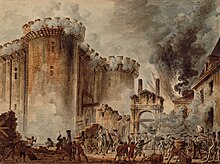 The Storming of the Bastille on 14 July 1789 was the starting event of the French Revolution.
The Storming of the Bastille on 14 July 1789 was the starting event of the French Revolution.After the storming of the Bastille on 14 July 1789, the absolute monarchy was abolished and France became a constitutional monarchy. Through the Declaration of the Rights of Man and of the Citizen, France established fundamental rights for French citizens (who could only be male). The Declaration affirms "the natural and imprescriptible rights of man" to "liberty, property, security and resistance to oppression". It called for the destruction of aristocratic privileges and proclaimed freedom and equal rights for all men, as well as access to public office based on talent rather than birth.
របបរាជានិយមត្រូវបានរឹតបន្តឹង ហើយប្រជាពលរដ្ឋទាំងអស់ត្រូវមានសិទ្ធិចូលរួមក្នុងដំណើរការនីតិបញ្ញត្តិ។ សេរីភាពនៃការបញ្ចេញមតិ និងសារព័ត៌មានត្រូវបានប្រកាស ហើយការចាប់ខ្លួនតាមអំពើចិត្តមិនត្រូវបានអនុញ្ញាត។ សេចក្តីថ្លែងការណ៍ក៏បានអះអាងនូវគោលការណ៍នៃអធិបតេយ្យភាពដ៏ពេញនិយម ដែលផ្ទុយពីសិទ្ធិដ៏ទេវភាពរបស់ស្តេចដែលកំណត់លក្ខណៈនៃរាជាធិបតេយ្យបារាំង និងសមភាពសង្គមក្នុងចំណោមប្រជាពលរដ្ឋ ដោយលុបបំបាត់ឯកសិទ្ធិរបស់អភិជន និងបព្វជិត។
While Louis XVI, as a constitutional king, enjoyed popularity among the population, his disastrous flight to Varennes seemed to justify rumours he had tied his hopes of political salvation to the prospects of foreign invasion. His credibility was deeply undermined to the extent that the abolition of the monarchy and establishment of a republic became an increasing possibility.
European monarchies gathered against the new régime, to restore the French absolute monarchy. The foreign threat exacerbated France's political turmoil and deepened the sense of urgency among the various factions and war was declared against Austria on 20 April 1792. Mob violence occurred during the insurrection of 10 August 1792[២៨] and the following month.[២៩] As a result of this violence and the political instability of the constitutional monarchy, the Republic was proclaimed on 22 September 1792.
Napoleon, Emperor of the French, and his Grande Armée built a vast Empire across Europe. He helped spread the French revolutionary ideals and his legal reforms had a major influence worldwide.Louis XVI was convicted of treason and guillotined in 1793. Facing increasing pressure from European monarchies, internal guerrilla wars and counterrevolutions (such as the War in the Vendée or the Chouannerie), the young Republic fell into the Reign of Terror. Between 1793 and 1794, between 16,000 and 40,000 people were executed. In Western France, the civil war between the Bleus ("Blues", supporters of the Revolution) and the Blancs ("Whites", supporters of the Monarchy) lasted from 1793 to 1796 and led to the loss of between 200,000 and 450,000 lives.[៣០][៣១]
Both foreign armies and French counterrevolutionnaries were crushed and the French Republic survived. Furthermore, it extended greatly its boundaries and established "Sister Republics" in the surrounding countries. As the threat of a foreign invasion receded and France became mostly pacified, the Thermidorian Reaction put an end to Robespierre's rule and to the Terror. The abolition of slavery and male universal suffrage, enacted during this radical phase of the revolution, were cancelled by subsequent governments.
After a short-lived governmental scheme, Napoleon Bonaparte seized control of the Republic in 1799 becoming First Consul and later Emperor of the French Empire (1804–1814/1815). As a continuation of the wars sparked by the European monarchies against the French Republic, changing sets of European Coalitions declared wars on Napoleon's Empire. His armies conquered most of continental Europe, while members of the Bonaparte family were appointed as monarchs in some of the newly established kingdoms.[៣២]
These victories led to the worldwide expansion of French revolutionary ideals and reforms, such as the Metric system, the Napoleonic Code and the Declaration of the Rights of Man. After the catastrophic Russian campaign, Napoleon was defeated and the Bourbon monarchy restored. About a million Frenchmen died during the Napoleonic Wars.[៣២]
Douaumont ossuary. With 4.3 million wounded from a population of only 39.6 million at the time, the Third French Republic sustained the highest number of total casualties among the Allies during World War I.After his brief return from exile, Napoleon was finally defeated in 1815 at the Battle of Waterloo, the monarchy was re-established (1815–1830), with new constitutional limitations. The discredited Bourbon dynasty was overthrown by the July Revolution of 1830, which established the constitutional July Monarchy, which lasted until 1848, when the French Second Republic was proclaimed, in the wake of the European Revolutions of 1848. The abolition of slavery and male universal suffrage, both briefly enacted during the French Revolution were re-enacted in 1848.
In 1852, the president of the French Republic, Louis-Napoléon Bonaparte, Napoleon I’s nephew, was proclaimed emperor of the second Empire, as Napoleon III. He multiplied French interventions abroad, especially in Crimea, in Mexico and Italy. Napoleon III was unseated following defeat in the Franco-Prussian War of 1870 and his regime was replaced by the Third Republic.
France had colonial possessions, in various forms, since the beginning of the 17th century. In the 19th and 20th centuries, its global overseas colonial empire extended greatly and became the second largest in the world behind the British Empire. Including metropolitan France, the total area of land under French sovereignty almost reached 13 million square kilometres in the 1920s and 1930s, 8.6% of the world's land.
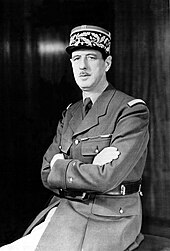 Charles de Gaulle took an active part in all major events of the 20th century: a hero of World War I, leader of the Free French during World War II, he then became President, where he facilitated decolonization, maintained France as a major power and overcame the revolt of May 1968.
Charles de Gaulle took an active part in all major events of the 20th century: a hero of World War I, leader of the Free French during World War II, he then became President, where he facilitated decolonization, maintained France as a major power and overcame the revolt of May 1968.France was a member of the Triple Entente when World War I broke out. A small part of Northern France was occupied, but France and its allies emerged victorious against the Central Powers, at a tremendous human and material cost. World War I left 1.4 million French soldiers dead, 4% of its population,[៣៣] between 27 and 30% of the conscript classes of 1912–1915.[៣៤]
The interbellum years were marked by intense international tensions and a variety of social reforms introduced by the Popular Front government (Annual leave, working time reduction, women in Government among others). France was occupied following the German Blitzkrieg campaign in World War II, with metropolitan France divided into a German occupation zone in the north and Vichy France, a newly established authoritarian regime collaborating with Germany, in the south.[៣៥] The Allies and the French Resistance eventually emerged victorious from the Axis powers and French sovereignty was restored.
The Fourth Republic was established after World War II and saw spectacular economic growth (les Trente Glorieuses). Suffrage was extended to women in 1944. France was one of the founding members of NATO (1949). France attempted to regain control of French Indochina but was defeated by the Viet Minh in 1954. Only months later, France faced a new conflict in Algeria. The debate over whether or not to keep control of Algeria, then home to over one million European settlers,[៣៦] wracked the country and nearly led to civil war.
In 1958, the weak and unstable Fourth Republic gave way to the Fifth Republic, which contained a strengthened Presidency.[៣៧] In the latter role, Charles de Gaulle managed to keep the country together while taking steps to end the war. The Algerian War was concluded with the Évian Accords in 1962 that led to Algerian independence. France granted independence progressively to its colonies. A vestige of the colonial empire are the French overseas departments and territories.
In the wake of the series of worldwide protests of 1968, the revolt of May 1968 had an enormous social impact. In France, it is considered to be the watershed moment when a conservative moral ideal (religion, patriotism, respect for authority) shifted towards a more liberal moral ideal.
ប្រទេសបារាំងបានឈានមុខគេក្នុងប្រទេសជាសមាជិកសហភាពអឺរ៉ុបដែលកំពុងស្វែងរកទុនលើសន្ទុះនៃសហជីពរូបិយវត្ថុដើម្បីបង្កើតឧបករណ៍នយោបាយ ការការពារ និងសន្តិសុខរបស់សហភាពអឺរ៉ុបដែលមានការរួបរួម និងមានសមត្ថភាពជាងមុន។[៣៨]
↑ ១,០ ១,១ ១,២ ១,៣ Jean Carpentier (dir.), François Lebrun (dir.), Alain Tranoy, Élisabeth Carpentier et Jean-Marie Mayeur (préface de Jacques Le Goff), Histoire de France, Points Seuil, coll. « Histoire », Paris, 2000 (1re éd. 1987), p. 17 ISBN 2-02-010879-8 ↑ Carpentier et al 2000, pp. 20–24 ↑ The Cambridge ancient history. Cambridge University Press. 2000. p. 754. ល.ស.ប.អ. 978-0-521-08691-2. http://books.google.com/books?id=n1TmVvMwmo4C&pg=RA1-PA754។ បានយកមក 23 January 2011. ↑ Claude Orrieux (1999). A history of ancient Greece. John Wiley & Sons. p. 62. ល.ស.ប.អ. 978-0-631-20309-4. http://books.google.com/books?id=b8cA8hymTw8C&pg=PA62។ បានយកមក 23 January 2011. ↑ Carpentier et al 2000, p. 29 ↑ Life magazine, 13 July 1953, p. 76. Google Books. 13 July 1953. http://books.google.com/?id=ZEIEAAAAMBAJ&pg=PA76។ បានយកមក 23 January 2011. ↑ Carpentier et al 2000, p.44-45 ↑ ៨,០ ៨,១ Carpentier et al 2000, pp. 53–55 ↑ Carpentier et al 2000, pp. 76–77 ↑ Carpentier et al 2000, pp. 79–82 ↑ Carpentier et al 2000, p. 81 ↑ Carpentier et al 2000, p. 84 ↑ Carpentier et al 2000, pp. 84–88 ↑ Faith of the Eldest Daughter – Can France retain her Catholic heritage?. Wf-f.org Archived from the original on 22 កក្កដា 2011 Retrieved on 17 July 2011 ↑ France. Berkley Center for Religion, Peace, and World Affairs Retrieved on 14 December 2011 See drop-down essay on "Religion and Politics until the French Revolution" ↑ Treaty of Verdun. History.howstuffworks.com (27 February 2008)Retrieved on 17 July 2011 ↑ History of France : The Capetian kings of France: AD 987–1328. Historyworld.net Retrieved on 21 July 2011 ↑ "Massacre of the Pure". Time (New York). 28 April 1961. http://www.time.com/time/magazine/article/0,9171,897752-2,00.html. ↑ ១៩,០ ១៩,១ ១៩,២ Albert Guerard, France: A Modern History (University of Michigan Press: Ann Arbor, 1959) pp. 100, 101. ↑ France VII Microsoft Encarta Online Encyclopedia 2009. Webcitation.org () Archived from the original on 29 សីហា 2009 Retrieved on 22 June 2012 ↑ Don O'Reilly. "Hundred Years' War: Joan of Arc and the Siege of Orléans". TheHistoryNet.com. ↑ Emmanuel Le Roy Ladurie (1987). "The French peasantry, 1450–1660". University of California Press. p. 32. ISBN 0-520-05523-3 ↑ Peter Turchin (2003). "Historical dynamics: why states rise and fall[តំណភ្ជាប់ខូច]". Princeton University Press. p. 179. ISBN 0-691-11669-5 ↑ Massacre of Saint Bartholomew’s Day. Britannica.com Retrieved on 21 July 2011 ↑ Language and Diplomacy. Nakedtranslations.com Retrieved on 21 July 2011 ↑ BBC History : Louis XV (1710–1774). BBC Retrieved on 21 July 2011 ↑ Scholarly bibliography by Colin Jones (2002) (PDF) Retrieved on 21 July 2011 ↑ Censer, Jack R. and Hunt, Lynn. Liberty, Equality, Fraternity: Exploring the French Revolution. University Park, Pennsylvania: Pennsylvania State University Press, 2004. ↑ Doyle, William. The Oxford History of The French Revolution. Oxford: Oxford University Press, 1989. pp 191–192. ↑ Dr Linton, Marisa. "The Terror in the French Revolution". Kingston University. http://www.port.ac.uk/special/france1815to2003/chapter1/interviews/filetodownload,20545,en.pdf. ↑ Jacques Hussenet (dir.), « Détruisez la Vendée ! » Regards croisés sur les victimes et destructions de la guerre de Vendée, La Roche-sur-Yon, Centre vendéen de recherches historiques, 2007 ↑ ៣២,០ ៣២,១ Blanning, Tim (April 1998). "Napoleon and German identity". History Today (London) 48. http://www.questia.com/googleScholar.qst?docId=5001329960. ↑ "France's oldest WWI veteran dies". BBC News (London). 20 January 2008. http://news.bbc.co.uk/2/hi/europe/7199127.stm. ↑ Spencer C. Tucker, Priscilla Mary Roberts (2005). "Encyclopedia Of World War I: A Political, Social, And Military History". ABC-CLIO. ISBN 1851094202 ↑ "Vichy France and the Jews". Michael Robert Marrus, Robert O. Paxton (1995). Stanford University Press. p. 368. ISBN 0-8047-2499-7 ↑ Kimmelman, Michael (4 March 2009). "In France, a War of Memories Over Memories of War". The New York Times. http://www.nytimes.com/2009/03/05/arts/design/05abroad.html?_r=1. ↑ From Fourth to Fifth Republic Archived 2008-05-23 at the វេយប៊ែខ ម៉ាស៊ីន. – University of Sunderland ↑ Declaration by the Franco-German Defense and Security Council. Elysee.fr Archived from the original on 25 October 2005 Retrieved on 21 July 2011








































